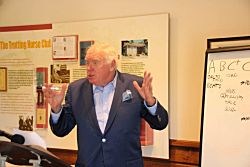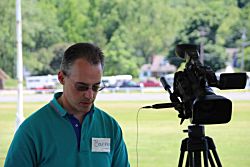Race calling workshop held at Historic Track
June 7, 2015,by Ellen Harvey, Harness Racing Communications
Goshen, NY — Nearly two dozen fans of Standardbred, Thoroughbred and Steeplechase racing checked off an item on their bucket lists Sunday (June 7) as they completed a class on race announcing taught by Tom Durkin, in a cooperative venture between the USTA, Harness Racing Museum and Goshen Historic Track.
Durkin, who has called races for more than 40 years, including the Hambletonian, all the Thoroughbred Triple Crown races and the Breeders’ Cup, taught the morning class before students called the 11 matinee races held at adjacent Historic Track in the afternoon.

Tom Durkin showed the class how he charts the expected pace of a race.
Durkin kept the class engaged with the story of his self-education in race announcing, incorporating his background performing in 17 plays, study of Latin and literature, as well as reading in how the brain works to help quickly memorize a large amount of information, forget it and then reload for another race.
He showed the class his 30 page booklets prepared for the major classics he’s called, complete with an analysis of the expected pace, phrases to use in the event of wins by horses in fields that could be as large as 20, color coding the program and the mechanics of how you can watch a race, hold binoculars and keep a program within eyesight.
“I designed this device (to which he clips his program) for myself using the three most common construction elements — a coat hanger, the cardboard that comes with your shirts in the laundry and duct or masking tape,” he said to laughs from the class. “It works great.”
Durkin emphasized the need to memorize and use repetition to ensure that the names of horses, drivers and trainers come easily and accurately. He also gave tips to avoid making mistakes, such as using the name of a horse in a race call first and then the position, a strategy that avoids the possibility of stating the position of a horse and then not being able to identify it (“In third place, it’s…uhhhhh.”)
Durkin detailed his preparation for races large and small and the necessity of approaching each with the scrutiny of a handicapper.
“It’s like Fred Astaire said when he was asked why his rehearsals were so hard,” Durkin said. “Because it makes the performance so much easier.”
After a short lunch break, the class moved to adjacent Historic Track, for 11 non betting, non-purse races. Announcer Howard Oil, the voice of Monticello Raceway, was on hand to introduce the students and help them through each call.

Chris Tully photos
Barry Abrams getting ready to call the first race of the day. He attended the class and called a race for his podcast, “In The Gate,” on ESPN.
Only three of the 11 races had fields larger than three, but a regular parade of 2-year-olds making their sometimes unsteady first starts kept the students busy. Every one of them made it from beginning to end with an occasional delayed horse or driver misidentification quickly corrected.
“The winning driver was Jason Bartlett, who bears a surprising resemblance to Jordan Stratton,” was the lighthearted correction from one student who called Bartlett by the name throughout the race.
For some, it was not their first race call, but their first time seeing a harness race. Dr. Dean Springer, who came from Barbados for the class and has called several hundred races there, noted the slower pace and need to adjust the thought process accordingly, as the crowd adjusted to his British-inflected Caribbean accent.
“It was different than what I’m used to, riders on their back, not drivers,” he said. “Getting used to the speed, a little slower, takes some getting used to.”
For a New Jersey guy, it was perhaps a stepping stone to a career in harness racing.
“It was fun and it will get more people out to the track if you give more opportunities like this to the fans,” said Richard Mattei, a regular Meadowlands racing fan, and a college student looking to transfer to Kentucky. “I did (call a race) at the Meadowlands once. I hit a contest and it got the attention of Darin Zoccali and I got to call a race. I would do anything (to call a race) because this is what I want to do with my life, call horse races.”
Paul Kirnos, whose Thoroughbred handicapping skills have landed him spots in national championships several times, left the announcers booth with a wide smile.
“I thought it was fantastic. It was a great experience, a lot more difficult than I thought it would be,” said Kirnos, who’s also a former hot walker and now a statistician. “It’s a beautiful track and Tom Durkin did an outstanding job. I’d definitely like to do it again; I think you can only improve as you do more.”
Tuition from the class was designated by Tom Durkin for the Saratoga Harness Museum and Hall of Fame, in Saratoga Springs, N.Y., where he is now a resident.
